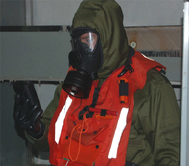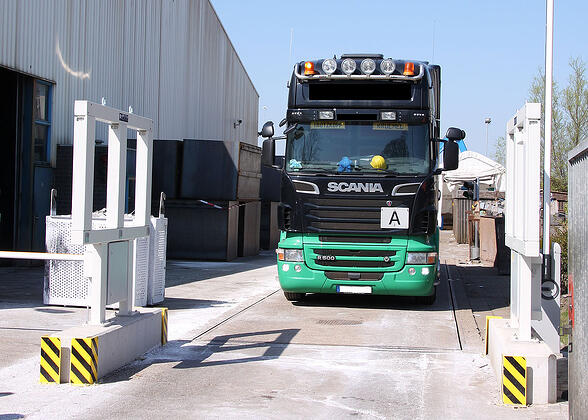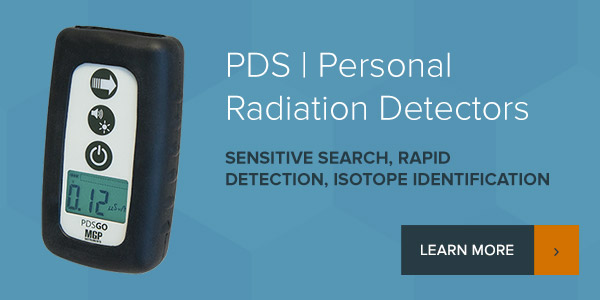Exploring settings where sensitive detection can make a difference.
Previously, we discussed the basics of sensitive radiation detection using the Personal Radiation Detector. Below are a few scenarios to illustrate how this kind of device can be used either on its own or as part of a larger radiation security plan. Since the PRD is a small, easily used instrument for detecting low levels of radiation, it excels in a variety of settings where radiation safety and security are a concern.
First Responders
One of the most basic applications for a Personal Radiation Detector is a unit clipped to the belt of first responder, like a police officer, firefighter, or hazmat team member. A small detector can be attached to their belt, set in active search mode, and will quietly look for any faint traces of radioactive material. The main goal in this type of scenario is to provide a first alert to the presence of radioactive material, where it’s located, and potentially the strength of the source. This information can then be evaluated so that the second wave of responders are appropriately equipped, or even trigger the deployment of more specialized teams with more sophisticated equipment.
 In the event of a radiological incident, such as a dirty bomb or an accident at a nuclear facility, the Personal Radiation Detector takes a back seat to more traditional survey equipment. However, despite being a more sensitive, low range device, it is still useful in establishing safe zones and in monitoring the boundaries of the affected area. This is especially valuable at established checkpoints for relief workers entering and exiting the incident zone.
In the event of a radiological incident, such as a dirty bomb or an accident at a nuclear facility, the Personal Radiation Detector takes a back seat to more traditional survey equipment. However, despite being a more sensitive, low range device, it is still useful in establishing safe zones and in monitoring the boundaries of the affected area. This is especially valuable at established checkpoints for relief workers entering and exiting the incident zone.
Customs and Border Protection
Another common function for this type of device is in the hands of a Customs agent, either at an airport or a border control station. In addition to the usual Customs inspection for undeclared items, contraband, and other “typical” smuggled materials, they are frequently equipped with Personal Radiation Detectors as a security measure to ensure that neither people coming into the country, nor their baggage, contains radioactive material.
In this scenario, the Customs agent would be equipped with the PRDs clipped to their belt as a passive, stealthy monitoring device. Should anything register on the PRD, that person or piece of baggage could then be directed to a secondary screening station. Here, someone with a more sensitive device (an identifier, most likely) will be there to do a more thorough scan to determine if it’s something relatively innocent and explainable, like a medical isotope, or something of more immediate concern.
Transportation Security
The role of the Personal Radiation Detector as a “first layer” of a larger screening process is common, and one where they tend to excel. They can easily be worn and used without alerting the public. This feature is very valuable for security officers on board airplanes, subways and passenger trains. They can very casually perform a first pass scan of other passengers and goods, and alert agents at screening stations at the destination to which individuals or baggage need to be pulled aside for further investigation or screening.
They also work well when paired with large-scale vehicle monitors or cargo container monitors, helping narrow down the exact location of detected material inside a larger space. In this setting, a PRD would act as a refined search tool, sweeping a car trunk, trailer or passenger compartment to find out exactly where a radioactive source might be hidden or secured.
Part of a Complete Radiation Security Program
The ultimate evolution of this strategy sees the PRD integrated into a full radiation security program. Large public events, such as political conferences, festivals, or sporting events like the World Cup, where hundreds or even thousands of people will be passing through in a single day, provide a serious challenge. In this type of setting, the Personal Radiation Detector, worn by security personnel, works well in conjunction with stationary walk-by area monitors to identify potential threats or people that warrant further investigation, who can be directed to secondary screening points where they can be cleared through large-scale portal monitors and hand held identifiers.
The Personal Radiation Detector is a versatile device for radiation security, scalable for use from the most common, everyday scenarios to the largest, special case, situations of most concern.
They are designed with early detection and prevention in mind, and work very well in the roles described above, as the first barrier to entry for radiological threats.


